oil MAZDA MODEL 6 2014 Owners Manual (in English)
[x] Cancel search | Manufacturer: MAZDA, Model Year: 2014, Model line: MODEL 6, Model: MAZDA MODEL 6 2014Pages: 576, PDF Size: 8.58 MB
Page 27 of 576

Black plate (27,1)
Have your seat belts changed immediately if the pretensioner or load limiter has
been expended:
Always have an Authorized Mazda Dealer immediately inspect the front seat belt
pretensioners and air bags after any collision. Like the air bags, the front seat belt
pretensioners and load limiters will only function once and must be replaced after
any collision that caused them to deploy. A seat belt with an expended pretensioner
or load limiter is still better than wearing no seat belt at all; however, if the front
seat belt pretensioners and load limiters are not replaced, the risk of injury in a
collision will increase.
Positioning the Shoulder Portion of the Seat Belt:
Improper positioning of the shoulder portion of the seat belt is dangerous. Always
make sure the shoulder portion of the seat belt is positioned across your shoulder
and near your neck, but never under your arm, on your neck, or on your upper arm.
Positioning the Lap Portion of the Seat Belt:
The lap portion of the seat belt worn too high is dangerous. In a collision, this would
concentrate the impact force directly on the abdominal area, causing serious injury.
Wear the lap portion of the belt snugly and as low as possible.
CAUTION
Belt retraction may become difficult if the belts and rings are soiled, so try to keep
them clean. For more details about cleaning the seat belts, refer to“Cleaning the
Lap/Shoulder Belt Webbing”(page 6-65).
Ring
Essential Safety Equipment
Seat Belt Systems
2-15
Mazda6_8DQ8-EA-13L_Edition3 Page27
Friday, June 13 2014 6:20 PM
Form No.8DQ8-EA-13L
Page 119 of 576
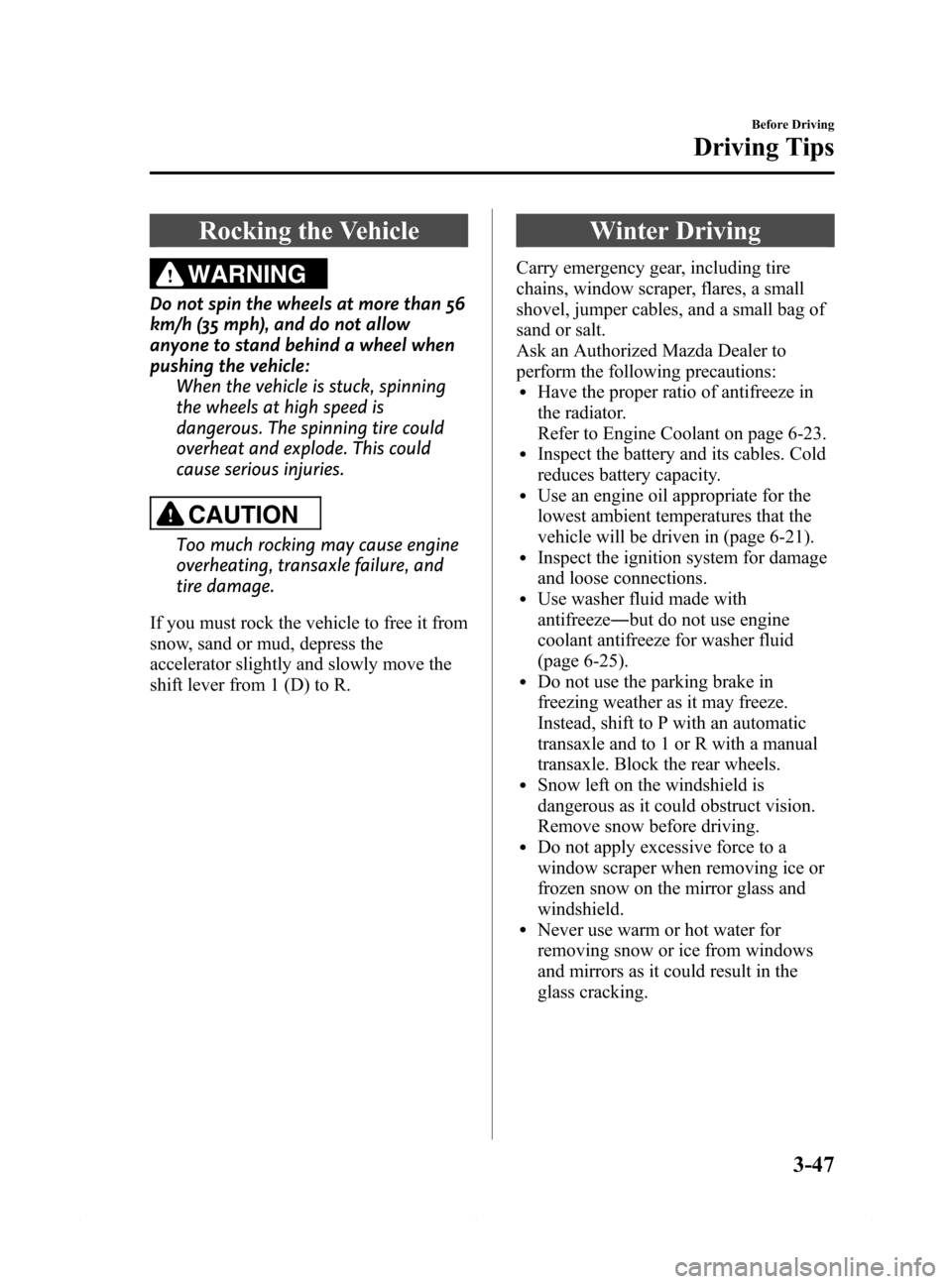
Black plate (119,1)
Rocking the Vehicle
WARNING
Do not spin the wheels at more than 56
km/h (35 mph), and do not allow
anyone to stand behind a wheel when
pushing the vehicle:
When the vehicle is stuck, spinning
the wheels at high speed is
dangerous. The spinning tire could
overheat and explode. This could
cause serious injuries.
CAUTION
Too much rocking may cause engine
overheating, transaxle failure, and
tire damage.
If you must rock the vehicle to free it from
snow, sand or mud, depress the
accelerator slightly and slowly move the
shift lever from 1 (D) to R.
Winter Driving
Carry emergency gear, including tire
chains, window scraper, flares, a small
shovel, jumper cables, and a small bag of
sand or salt.
Ask an Authorized Mazda Dealer to
perform the following precautions:
lHave the proper ratio of antifreeze in
the radiator.
Refer to Engine Coolant on page 6-23.
lInspect the battery and its cables. Cold
reduces battery capacity.
lUse an engine oil appropriate for the
lowest ambient temperatures that the
vehicle will be driven in (page 6-21).
lInspect the ignition system for damage
and loose connections.
lUse washer fluid made with
antifreeze―but do not use engine
coolant antifreeze for washer fluid
(page 6-25).
lDo not use the parking brake in
freezing weather as it may freeze.
Instead, shift to P with an automatic
transaxle and to 1 or R with a manual
transaxle. Block the rear wheels.
lSnow left on the windshield is
dangerous as it could obstruct vision.
Remove snow before driving.
lDo not apply excessive force to a
window scraper when removing ice or
frozen snow on the mirror glass and
windshield.
lNever use warm or hot water for
removing snow or ice from windows
and mirrors as it could result in the
glass cracking.
Before Driving
Driving Tips
3-47
Mazda6_8DQ8-EA-13L_Edition3 Page119
Friday, June 13 2014 6:21 PM
Form No.8DQ8-EA-13L
Page 149 of 576
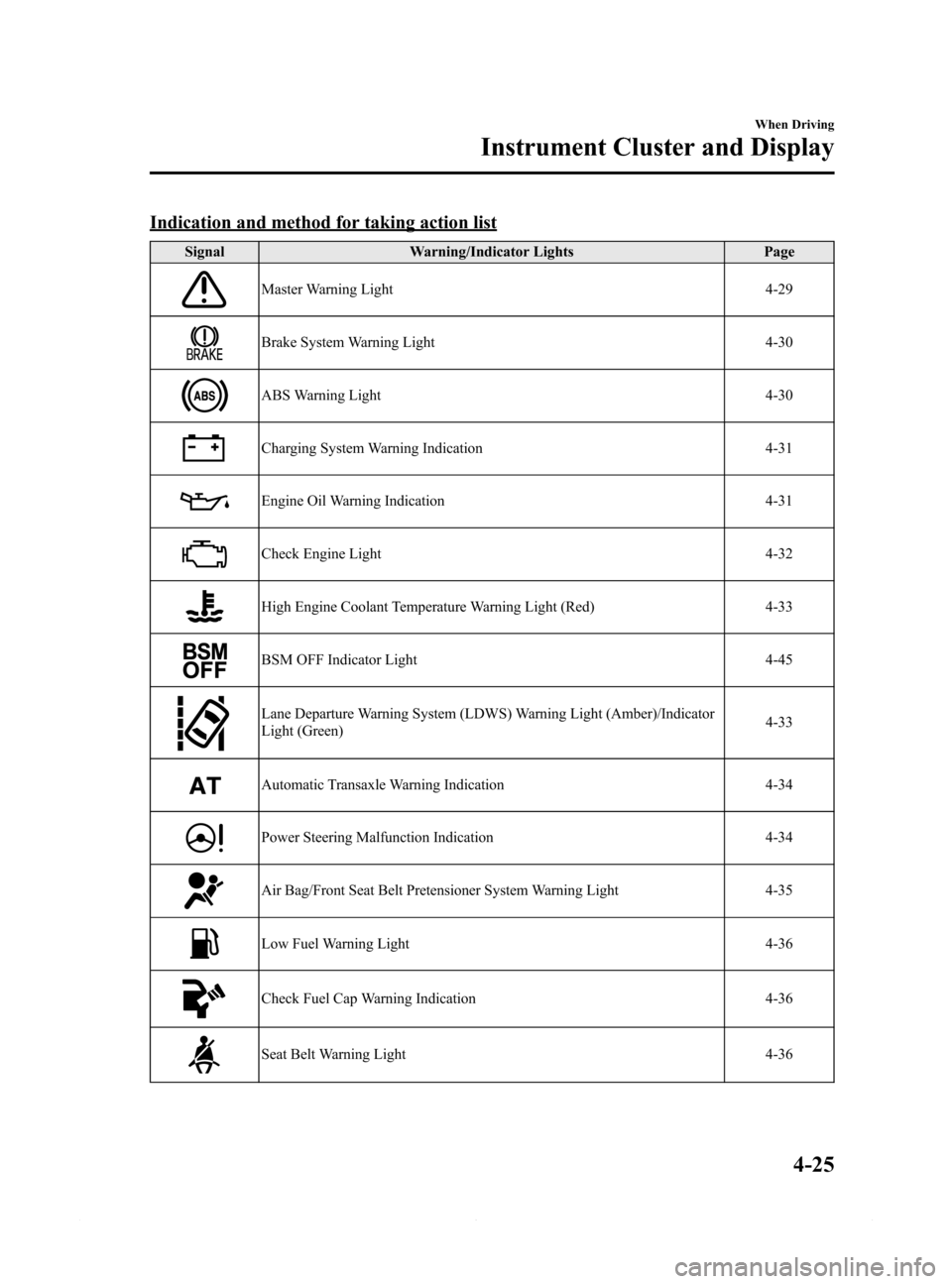
Black plate (149,1)
Indication and method for taking action list
Signal Warning/Indicator Lights Page
Master Warning Light 4-29
Brake System Warning Light 4-30
ABS Warning Light 4-30
Charging System Warning Indication 4-31
Engine Oil Warning Indication 4-31
Check Engine Light 4-32
High Engine Coolant Temperature Warning Light (Red) 4-33
BSM OFF Indicator Light 4-45
Lane Departure Warning System (LDWS) Warning Light (Amber)/Indicator
Light (Green)4-33
Automatic Transaxle Warning Indication 4-34
Power Steering Malfunction Indication 4-34
Air Bag/Front Seat Belt Pretensioner System Warning Light 4-35
Low Fuel Warning Light 4-36
Check Fuel Cap Warning Indication 4-36
Seat Belt Warning Light 4-36
When Driving
Instrument Cluster and Display
4-25
Mazda6_8DQ8-EA-13L_Edition3 Page149
Friday, June 13 2014 6:21 PM
Form No.8DQ8-EA-13L
Page 151 of 576

Black plate (151,1)
Signal Warning/Indicator Lights Page
Turn Signal/Hazard Warning Indicator Lights 4-44
Security Indicator Light 4-44
Cruise Main Indicator Light (Amber)/Cruise Set Indicator Light (Green) 4-45
Mazda Radar Cruise Control (MRCC) Warning Light (Amber)/Indicator
Light (Green)4-45
Lights-On Indicator Light 4-46
qType B
Warning/Indicator lights will appear in any of the highlighted areas
Signal Warning/Indicator Lights Page
Master Warning Light 4-29
Brake System Warning Light 4-30
ABS Warning Light 4-30
Charging System Warning Light 4-31
Engine Oil Warning Light 4-31
When Driving
Instrument Cluster and Display
4-27
Mazda6_8DQ8-EA-13L_Edition3 Page151
Friday, June 13 2014 6:21 PM
Form No.8DQ8-EA-13L
Page 155 of 576

Black plate (155,1)
qElectronic Brake Force
Distribution System Warning
If the electronic brake force distribution
control unit determines that some
components are operating incorrectly, the
control unit may illuminate the brake
system warning light and the ABS
warning light simultaneously. The
problem is likely to be the electronic
brake force distribution system.
WARNING
Do not drive with both the ABS warning
light and brake warning light
illuminated. Have the vehicle towed to
an Authorized Mazda Dealer to have
the brakes inspected as soon as
possible:
Driving when the brake system
warning light and ABS warning light
are illuminated simultaneously is
dangerous.
When both lights are illuminated, the
rear wheels could lock more quickly
in an emergency stop than under
normal circumstances.
qCharging System Warning
Indication/Warning Light
Type B
This warning light illuminates when the
ignition is switched ON and turns off
when the engine is started.
Type A/Type B
If the warning light/indication illuminates
while driving, it indicates a malfunction
of the alternator or of the charging system.
Drive to the side of the road and park off
the right-of-way. Consult an Authorized
Mazda Dealer.
CAUTION
Do not continue driving when the
charging system warning light is
illuminated because the engine could
stop unexpectedly.
qEngine Oil Warning Indication/
Warning Light
Type B
This warning light illuminates when the
ignition is switched ON and turns off
when the engine is started.
When Driving
Instrument Cluster and Display
4-31
Mazda6_8DQ8-EA-13L_Edition3 Page155
Friday, June 13 2014 6:21 PM
Form No.8DQ8-EA-13L
Page 156 of 576
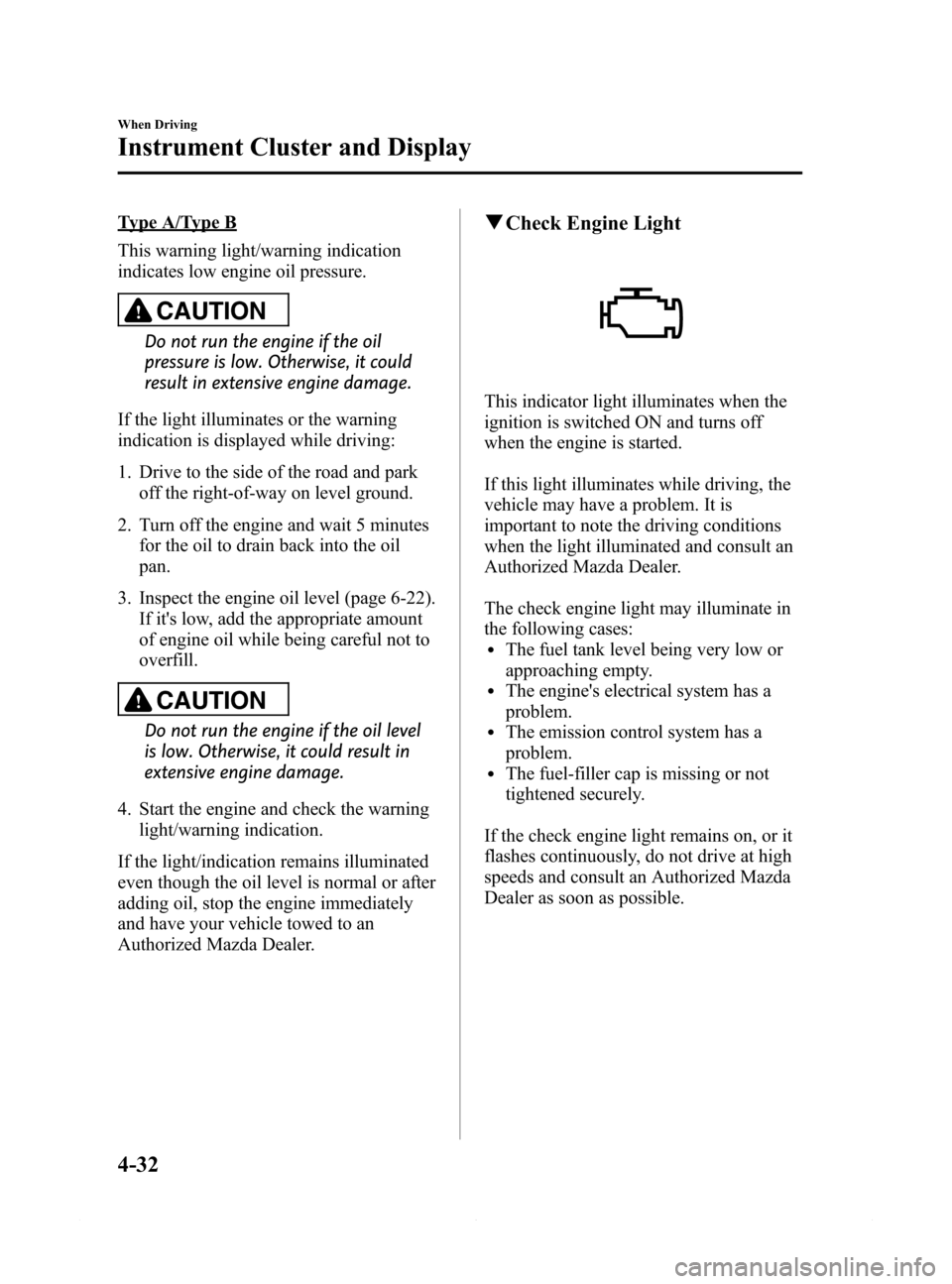
Black plate (156,1)
Type A/Type B
This warning light/warning indication
indicates low engine oil pressure.
CAUTION
Do not run the engine if the oil
pressure is low. Otherwise, it could
result in extensive engine damage.
If the light illuminates or the warning
indication is displayed while driving:
1. Drive to the side of the road and park
off the right-of-way on level ground.
2. Turn off the engine and wait 5 minutes
for the oil to drain back into the oil
pan.
3. Inspect the engine oil level (page 6-22).
If it's low, add the appropriate amount
of engine oil while being careful not to
overfill.
CAUTION
Do not run the engine if the oil level
is low. Otherwise, it could result in
extensive engine damage.
4. Start the engine and check the warning
light/warning indication.
If the light/indication remains illuminated
even though the oil level is normal or after
adding oil, stop the engine immediately
and have your vehicle towed to an
Authorized Mazda Dealer.
qCheck Engine Light
This indicator light illuminates when the
ignition is switched ON and turns off
when the engine is started.
If this light illuminates while driving, the
vehicle may have a problem. It is
important to note the driving conditions
when the light illuminated and consult an
Authorized Mazda Dealer.
The check engine light may illuminate in
the following cases:
lThe fuel tank level being very low or
approaching empty.
lThe engine's electrical system has a
problem.
lThe emission control system has a
problem.
lThe fuel-filler cap is missing or not
tightened securely.
If the check engine light remains on, or it
flashes continuously, do not drive at high
speeds and consult an Authorized Mazda
Dealer as soon as possible.
4-32
When Driving
Instrument Cluster and Display
Mazda6_8DQ8-EA-13L_Edition3 Page156
Friday, June 13 2014 6:21 PM
Form No.8DQ8-EA-13L
Page 203 of 576

Black plate (203,1)
CAUTION
Heed the following precautions to assure correct operation of each system.
ØDo not adhere stickers (including transparent stickers) to the surface of the
radiator grille and front emblem in and around the radar sensor, and do not
replace the radiator grille and front emblem with any product that is not a
genuine product designed for use with the radar sensor.
ØThe radar sensor includes a function for detecting soiling of the radar sensor's
front surface and informing the driver, however, depending on the conditions, it
may require time to detect or it may not detect plastic shopping bags, ice or snow.
If this occurs, the system may not operate correctly, therefore always keep the
radar sensor clean.
ØDo not install a grille guard.
ØIf the front part of the vehicle has been damaged in a vehicle accident, the
position of the radar sensor may have moved. Stop the system immediately and
always have the vehicle inspected at an Authorized Mazda Dealer.
ØDo not use the front bumper to push other vehicles or obstructions such as when
pulling out of a parking space. Otherwise, the radar sensor could be hit and its
position deviated.
ØDo not remove, disassemble, or modify the radar sensor.
ØFor repairs, replacement or paint work around the radar sensor, consult an
Authorized Mazda Dealer.
ØDo not modify the suspension. If the suspension are modified, the vehicle's posture
could change and the radar sensor may not be able to correctly detect a vehicle
ahead or an obstruction.
When Driving
Radar Sensor
4-79
Mazda6_8DQ8-EA-13L_Edition3 Page203
Friday, June 13 2014 6:21 PM
Form No.8DQ8-EA-13L
Page 204 of 576
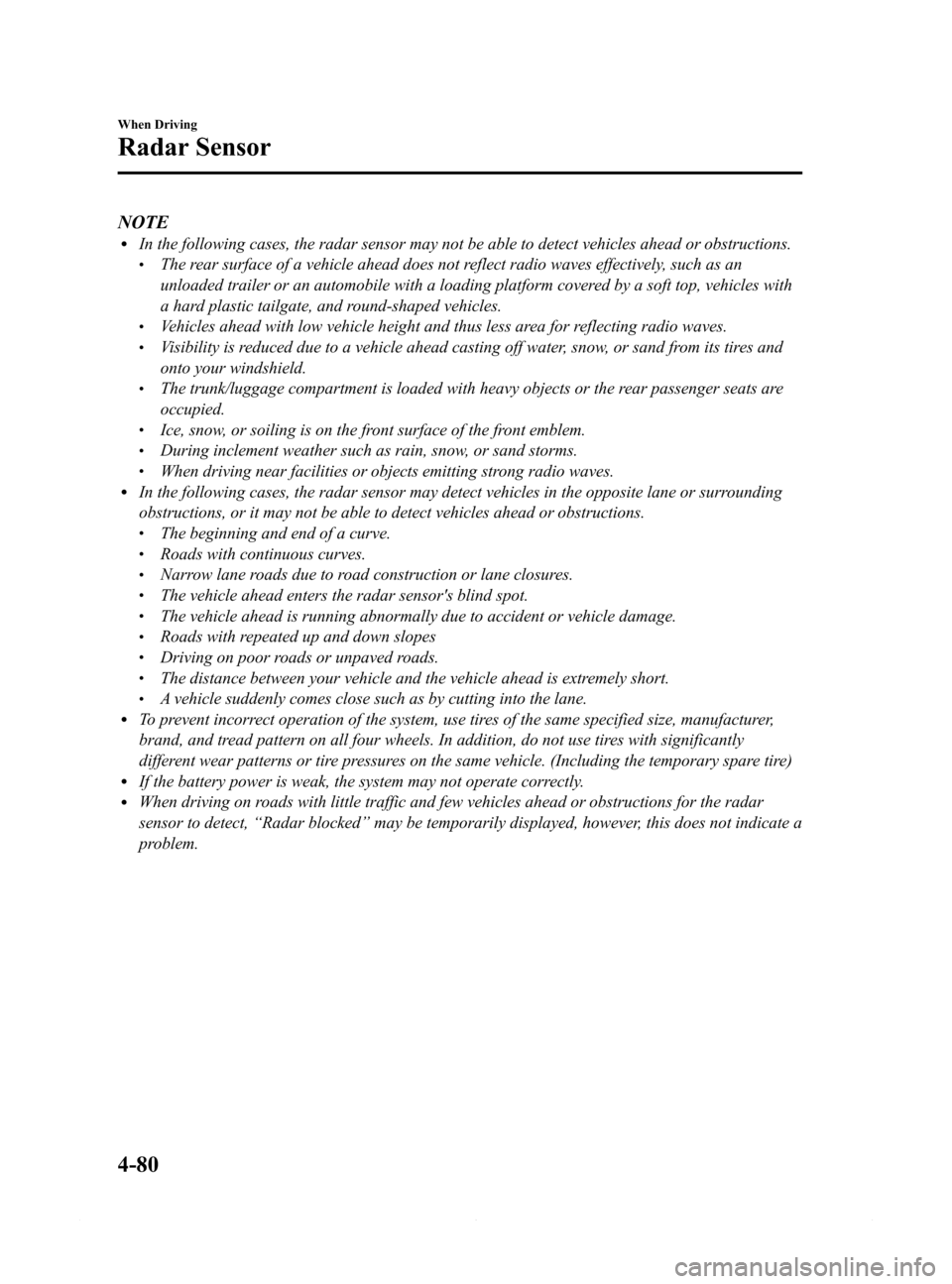
Black plate (204,1)
NOTElIn the following cases, the radar sensor may not be able to detect vehicles ahead or obstructions.lThe rear surface of a vehicle ahead does not reflect radio waves effectively, such as an
unloaded trailer or an automobile with a loading platform covered by a soft top, vehicles with
a hard plastic tailgate, and round-shaped vehicles.
lVehicles ahead with low vehicle height and thus less area for reflecting radio waves.lVisibility is reduced due to a vehicle ahead casting off water, snow, or sand from its tires and
onto your windshield.
lThe trunk/luggage compartment is loaded with heavy objects or the rear passenger seats are
occupied.
lIce, snow, or soiling is on the front surface of the front emblem.lDuring inclement weather such as rain, snow, or sand storms.lWhen driving near facilities or objects emitting strong radio waves.lIn the following cases, the radar sensor may detect vehicles in the opposite lane or surrounding
obstructions, or it may not be able to detect vehicles ahead or obstructions.
lThe beginning and end of a curve.lRoads with continuous curves.lNarrow lane roads due to road construction or lane closures.lThe vehicle ahead enters the radar sensor's blind spot.lThe vehicle ahead is running abnormally due to accident or vehicle damage.lRoads with repeated up and down slopeslDriving on poor roads or unpaved roads.lThe distance between your vehicle and the vehicle ahead is extremely short.lA vehicle suddenly comes close such as by cutting into the lane.lTo prevent incorrect operation of the system, use tires of the same specified size, manufacturer,
brand, and tread pattern on all four wheels. In addition, do not use tires with significantly
different wear patterns or tire pressures on the same vehicle. (Including the temporary spare tire)
lIf the battery power is weak, the system may not operate correctly.lWhen driving on roads with little traffic and few vehicles ahead or obstructions for the radar
sensor to detect,“Radar blocked”may be temporarily displayed, however, this does not indicate a
problem.
4-80
When Driving
Radar Sensor
Mazda6_8DQ8-EA-13L_Edition3 Page204
Friday, June 13 2014 6:21 PM
Form No.8DQ8-EA-13L
Page 212 of 576

Black plate (212,1)
CAUTION
ØWhen driving off-road in areas where there is grass or forage, it is recommended
that the Smart City Brake Support (SCBS) system be turned off.
ØAlways use tires for all wheels that are of the specified size, and the same
manufacture, brand, and tread pattern. In addition, do not use tires with
significantly different wear patterns on the same vehicle. Do not use tires with
significantly different wear patterns on the same vehicle as the Smart City Brake
Support (SCBS) system may not operate normally.
ØThe laser sensor includes a function for detecting a soiled windshield and
informing the driver, however, depending on the conditions, it may not detect
plastic shopping bags, ice or snow on the windshield. In such cases, the system
cannot accurately determine a vehicle ahead and may not be able to operate
normally. Always drive carefully and pay attention to the road ahead.
4-88
When Driving
Brake
Mazda6_8DQ8-EA-13L_Edition3 Page212
Friday, June 13 2014 6:21 PM
Form No.8DQ8-EA-13L
Page 246 of 576
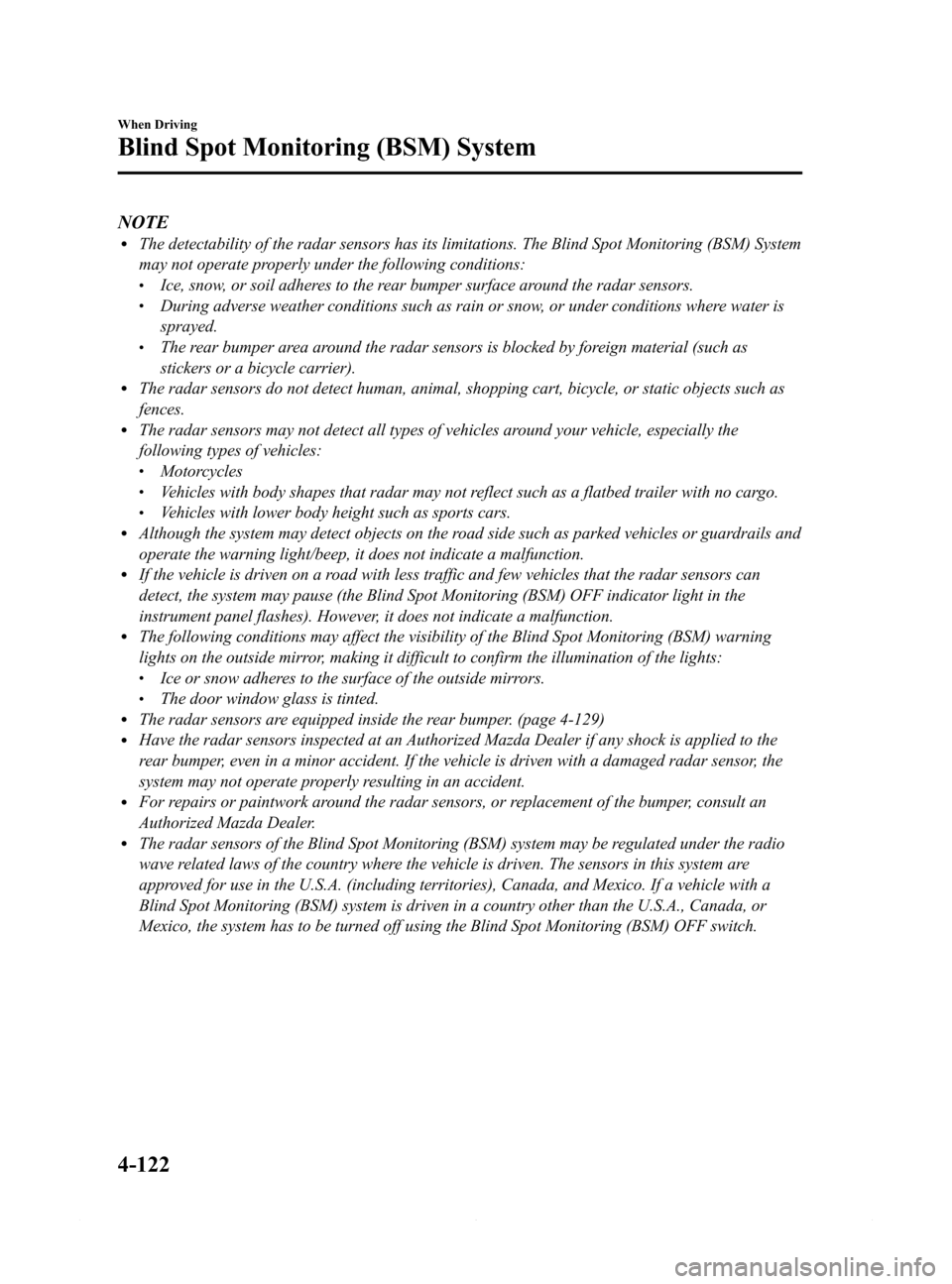
Black plate (246,1)
NOTElThe detectability of the radar sensors has its limitations. The Blind Spot Monitoring (BSM) System
may not operate properly under the following conditions:
lIce, snow, or soil adheres to the rear bumper surface around the radar sensors.lDuring adverse weather conditions such as rain or snow, or under conditions where water is
sprayed.
lThe rear bumper area around the radar sensors is blocked by foreign material (such as
stickers or a bicycle carrier).
lThe radar sensors do not detect human, animal, shopping cart, bicycle, or static objects such as
fences.
lThe radar sensors may not detect all types of vehicles around your vehicle, especially the
following types of vehicles:
lMotorcycleslVehicles with body shapes that radar may not reflect such as a flatbed trailer with no cargo.lVehicles with lower body height such as sports cars.lAlthough the system may detect objects on the road side such as parked vehicles or guardrails and
operate the warning light/beep, it does not indicate a malfunction.
lIf the vehicle is driven on a road with less traffic and few vehicles that the radar sensors can
detect, the system may pause (the Blind Spot Monitoring (BSM) OFF indicator light in the
instrument panel flashes). However, it does not indicate a malfunction.
lThe following conditions may affect the visibility of the Blind Spot Monitoring (BSM) warning
lights on the outside mirror, making it difficult to confirm the illumination of the lights:
lIce or snow adheres to the surface of the outside mirrors.lThe door window glass is tinted.lThe radar sensors are equipped inside the rear bumper. (page 4-129)lHave the radar sensors inspected at an Authorized Mazda Dealer if any shock is applied to the
rear bumper, even in a minor accident. If the vehicle is driven with a damaged radar sensor, the
system may not operate properly resulting in an accident.
lFor repairs or paintwork around the radar sensors, or replacement of the bumper, consult an
Authorized Mazda Dealer.
lThe radar sensors of the Blind Spot Monitoring (BSM) system may be regulated under the radio
wave related laws of the country where the vehicle is driven. The sensors in this system are
approved for use in the U.S.A. (including territories), Canada, and Mexico. If a vehicle with a
Blind Spot Monitoring (BSM) system is driven in a country other than the U.S.A., Canada, or
Mexico, the system has to be turned off using the Blind Spot Monitoring (BSM) OFF switch.
4-122
When Driving
Blind Spot Monitoring (BSM) System
Mazda6_8DQ8-EA-13L_Edition3 Page246
Friday, June 13 2014 6:21 PM
Form No.8DQ8-EA-13L